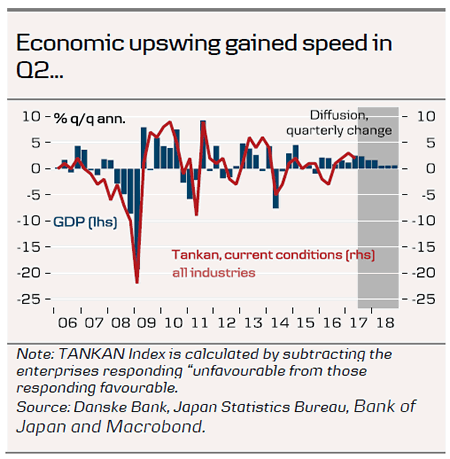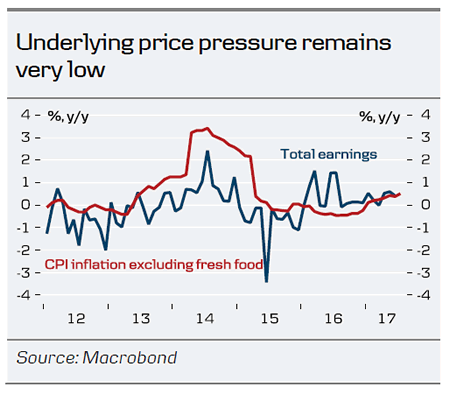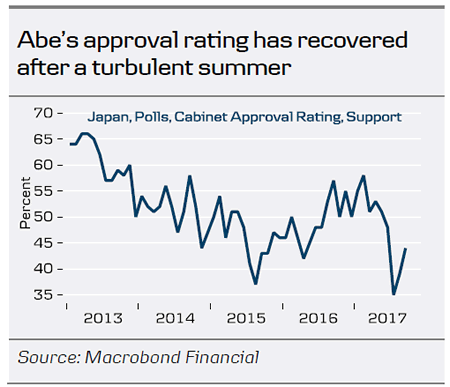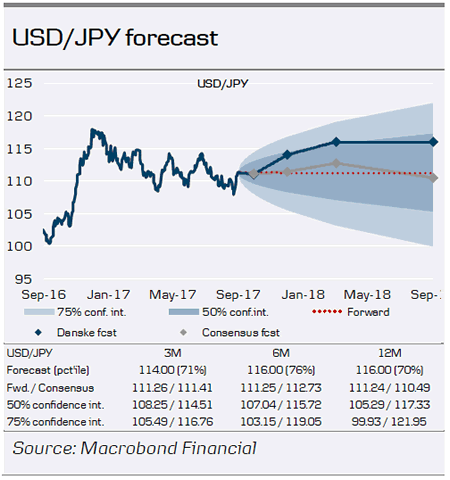- We expect the Bank of Japan (BoJ) to maintain its ‘QQE with yield curve control’ policy unchanged at its monetary policy meeting ending on 21 September.
- Political uncertainty is likely to increase in Japan where the focus will in particular centre on whether PM Abe calls for an early general election, and not least whether BoJ governor Koruda will be re-appointed to lead the BoJ for another five years when his current term ends in April 2018.
- In our main scenario, we expect the BoJ to keep its policy unchanged throughout our 12M forecast horizon, assuming that BoJ governor Koruda is re-appointed.
- We look for USD/JPY to remain range bound in the near term as political uncertainty (both in relation to North Korea and domestically in Japan) is likely to counter most of the JPY depreciation potential. Longer term, we expect USD/JPY to increase, targeting 114 in 3M and 116 in 6-12M.
- Tactically, we prefer to stay sidelined USD/JPY as highly unpredictable political risks leave a less attractive risk/reward. EUR- and DKK-based corporates should hedge JPY income with FX forwards.
We expect the Bank of Japan (BoJ) to maintain its ‘QQE with yield curve control’ policy unchanged at its monetary policy meeting ending on 21 September. It is widely expected that the BoJ will keep its monetary policy unchanged and that the announcement should not have any significant impact on price actions.
The Japanese economy is currently running on all engines, and GDP growth picked up speed in Q2 with at annualised growth of 2.5%. CPI inflation has also been increasing through 2017, but it has mainly been due to rising energy prices. Hence, the underlying price pressure in Japan remains very low, despite solid growth and a closed output gap, and the BoJ’s 2% inflation target is currently nowhere within reach. See Research Japan: Running on all engines (12 September) for more details.


New board members less likely to oppose Kuroda’s policy
The 20-21 September meeting will be the first meeting for the two new board members, Hitoshi Suzuki and Goshi Kataoka, who have been appointed by Japan’s parliament to replace the two frequent dissenters on the board, Takahide Kiuchi and Takehiro Sato, as their five-year terms ended in July. Kataoka has an economic background and is viewed as a reflationist who is likely to support the BoJ’s large-scale monetary easing, while Suzuki comes from a position in Tokyo-Mitsubishi UFJ’s financial market operations, and both new members are less likely to oppose Koruda’s policy. Hence, with the arrival of Kataoka and Suzuki the BoJ board will move in a more dovish direction and the nominations underscore that the Abe administration wants the BoJ to continue its current expansionary stimulus programme.
In terms of the BoJ, the focus will gradually turn to the question of who will be the next BoJ governor as Koruda’s term as BoJ governor expires in April 2018. The decision about the next BoJ governor is expected by end-2017 and we still think it is most likely that Koruda will be reappointed. But uncertainty could create some volatility and induce JPY appreciation pressure, as the nomination of another candidate could be viewed as a signal that the government is expecting the BoJ to exit its current monetary policy
Rising political uncertainty the main risk to the BoJ’s policy
The government’s approval rating has recovered somewhat following a turbulent summer when a series of scandals involving PM Abe and his close political allies led to a plunge in the government’s approval rating. The cabinet reshuffle in August has probably helped to improve his image, but political uncertainty is likely to remain high as the political calendar in Japan is packed with important events in the coming years.
During the autumn, the focus will be on the FY 2018 budget negotiations and not least the nomination of the next BoJ governor. Moreover, there has been some speculation whether PM Abe will dissolve the Lower House and call for an early general election in an attempt to strengthen his powerbase ahead of the LDP presidential election in September 2018 and the Upper House election in July 2019. As markets will probably link the fate of the Abe administration to the current accommodative policy regime (Abenomics), a potential change in leadership is likely to affect the expected outlook for fiscal and monetary policy.

FX outlook: higher USD/JPY and EUR/JPY in 6-12 months
While the combination of strong global PMIs and postponement of US debt limit risk is good for risk appetite and has improved the prospect of a higher USD/JPY in the near term, geopolitical uncertainty related to North Korea still represents a substantial downside risk and will continue to weigh on the cross. According to the latest IMM data, non-commercial JPY positioning is now back in stretched short territory, suggesting risks are tilted to the downside for USD/JPY from a positioning point of view. We still expect USD/JPY to trade within the 108-111 range near term targeting 111 in 1M and 114 in 3M. Fundamentally, we still see a case for a higher USD/JPY over the medium term horizon, driven by Fed-BoJ divergence, higher global yields (eventually) supported by global growth recovery and portfolio outflow out of Japan. We target USD/JPY at 116 in 6-12M.

EUR/JPY has proved to be less sensitive to negative risk sentiment driven by North Korean woes (declines in USD/JPY have been echoed by drops in EUR/USD). However, if the crisis escalates significantly, EUR/JPY would also take a plunge in our view. We look for EUR/JPY to trade in the range of 128-135 in the near term, targeting 135 in 3M. Longer term, we expect EUR/JPY to continue higher driven by real interest rates and portfolio outflows out of Japan as we expect the ECB to move towards monetary policy ‘normalisation’ before the BoJ. We target EUR/JPY at 141.50 in 6M and 145 in 12M.

FX strategy
Leveraged funds
While the underlying fundamentals combined with the postponement of the US debt limit risk support the case for a higher USD/JPY in the coming months, we prefer to stay sidelined USD/JPY for now. In our view, the combination of highly unpredictable political risks related to North Korea, and the risk of rising volatility and JPY appreciation pressure driven by domestic political uncertainty in Japan, leaves a less attractive risk/reward.
Corporates
We recommend EUR- and DKK-based corporates to hedge JPY income with FX forwards, while JPY expenses should be hedged via knock-in forwards.












